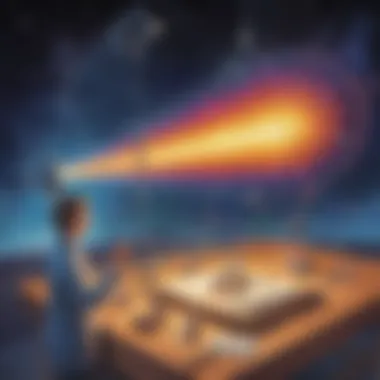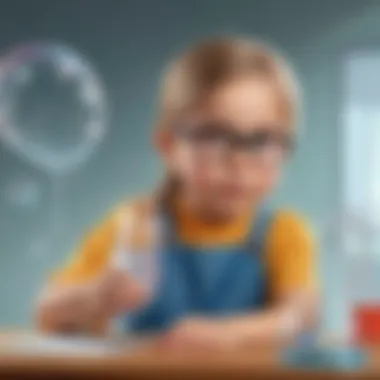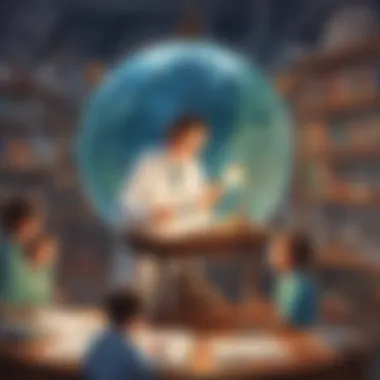Engage Young Minds with Fascinating Science Experiments for Children


Fun Activities Ideas
Indoor Activities
Indoor Activities offer a world of exploration within the confines of a cozy home environment. Through experiments like creating homemade slime or constructing paper airplanes to understand aerodynamics, children can engage in educational fun while staying indoors. These activities not only entertain but also educate, making learning an enjoyable experience.
Outdoor Adventures
Venturing outdoors opens up a realm of possibilities for interactive and educational experiences. From exploring nature and going on scavenger hunts to observing plant growth or building simple machines, outdoor adventures provide a hands-on approach to learning about the world around us. These activities promote physical activity while enhancing scientific knowledge in a natural setting.
Arts and Crafts
Arts and Crafts activities blend creativity with scientific concepts to encourage children to express themselves while learning. From creating colorful volcano eruptions using baking soda and vinegar to crafting kaleidoscopes to study light and reflection, these projects help youngsters discover fundamental principles through artistic expression. Through arts and crafts, children can fuse imagination with science, resulting in a holistic learning experience.
Science Experiments
The section on Science Experiments will feature a diverse array of easy and engaging projects designed to pique children's scientific curiosity. Simple experiments like making a lemon battery or observing the effects of food coloring in water can unveil basic scientific principles in a hands-on manner. These experiments foster critical thinking skills and a deeper understanding of scientific phenomena.
Cooking and Baking
Cooking and Baking activities offer a tasty way to explore science in the kitchen. From observing the chemical reactions that occur while baking bread to understanding the properties of liquids through making homemade ice cream, culinary experiments provide a delectable approach to learning science. Children can enhance their culinary skills while gaining insights into the scientific principles behind cooking and baking.
Introduction
Welcome to Gigglyx
Brief Description of Gigglyx
Gigglyx is not just any ordinary platform; it is an innovative space where children's natural curiosity meets the wonders of science. Offering a unique blend of education and entertainment, Gigglyx stands out for its immersive approach to learning. By combining fun and education, Gigglyx creates a stimulating environment that fosters a love for exploration and discovery. This integration of play and science makes Gigglyx a standout choice for young learners.


Detailed Description of Gigglyx
At Gigglyx, every detail is designed with children's learning and development in mind. From interactive experiments to captivating demonstrations, Gigglyx ensures that science comes alive in a way that resonates with young minds. The platform's focus on hands-on activities and engaging content sets it apart, providing children with an enriching experience that enhances their understanding of scientific concepts.
Target Audience of Gigglyx
Gigglyx caters to a diverse audience of young learners eager to explore the wonders of science. Whether it's curious preschoolers, inquisitive grade-schoolers, or budding scientists in the making, Gigglyx offers something for everyone. By tailoring its content to different age groups and learning styles, Gigglyx ensures that each child can find a meaningful connection to the world of science.
Importance of Science Experiments for Kids
Development of Critical Thinking
Science experiments play a crucial role in developing critical thinking skills in children by encouraging them to ask questions, make observations, and draw conclusions based on evidence. Through hands-on experimentation, children learn to think analytically, solve problems creatively, and approach challenges with a scientific mindset. This process of inquiry and discovery lays the foundation for strong cognitive abilities and fosters a lifelong love for learning.
Hands-On Learning Experience
Hands-on learning is central to the success of science experiments for kids, as it allows children to actively engage with the material and concepts being taught. By touching, seeing, and doing, young learners gain a deeper understanding of scientific principles and processes. This experiential approach not only boosts retention and comprehension but also cultivates a sense of accomplishment and confidence in children's scientific abilities.
Fostering Curiosity and Exploration
Curiosity is a driving force behind scientific exploration, and science experiments help spark and cultivate this innate curiosity in children. By providing opportunities for hands-on discovery, experiments ignite a sense of wonder and encourage children to explore the world around them. This spirit of curiosity leads to a greater appreciation for the natural world, motivates children to ask questions, and inspires a lifelong passion for scientific inquiry.
Chemical Reactions
Chemical reactions play a pivotal role in enriching the scientific exploration experience for young minds. By exploring the realm of chemical reactions, children are exposed to the fascinating world of matter transformation. Understanding chemical reactions helps in developing critical thinking skills as kids observe the changes occurring before their eyes. This section delves into the excitement and educational value of chemical reactions, offering a hands-on approach to learning that is both fun and enlightening.
Volcano Eruption
Materials Needed
In this captivating experiment, the materials required are easily accessible household items, fostering simplicity and convenience for both parents and educators. Ingredients like baking soda, vinegar, dish soap, and food coloring form the core of this volcanic eruption demonstration. These materials are not only safe for children but also serve as a fantastic illustration of chemical reactions in action. The availability and affordability of these components make the volcano eruption experiment a favored choice for engaging young learners in scientific exploration. Their interaction generates a thrilling visual effect that ignites curiosity and sparks a deeper interest in chemistry.


Procedure
The procedure for the volcano eruption experiment involves a structured yet dynamic approach, guiding participants through each step with clarity and excitement. Mixing the baking soda and vinegar leads to a bubbling reaction, mimicking volcanic activity in a safe and controlled environment. The addition of dish soap and food coloring enhances the visual appeal of the eruption, making it a memorable and impactful learning experience for children. This hands-on activity not only demonstrates basic chemical reactions but also emphasizes the importance of following instructions and understanding scientific processes. Overall, the volcano eruption experiment encapsulates both entertainment and education, making it a must-try for budding scientists and curious minds.
Physics Experiments
In this section of the article, we delve into the fascinating world of physics experiments for kids. Physics experiments play a crucial role in children's scientific education by allowing them to explore and understand the fundamental laws that govern the physical world. By engaging in hands-on activities related to physics, children develop essential skills such as critical thinking, problem-solving, and creativity.
Physics experiments provide a practical application of theoretical principles, making abstract concepts more tangible and comprehensible for young minds. Through these experiments, children can witness the direct correlation between cause and effect, fostering a deeper understanding of natural phenomena. Furthermore, physics experiments spark curiosity and excitement, encouraging children to question, observe, and explore the world around them.
DIY Hovercraft
Materials Needed
The DIY Hovercraft experiment requires a few simple materials that are easily accessible and safe for children to use. You will need a foam plate, a bottle cap, a balloon, a CD, and some tape. These materials are chosen for their lightweight and buoyant properties, ideal for constructing a functioning hovercraft.
The foam plate serves as the base of the hovercraft, providing a smooth surface for the hovercraft to glide on. The bottle cap acts as a nozzle for the airflow generated by the balloon, creating the necessary lift for the hovercraft to levitate. The CD functions as the hovercraft's platform, offering stability and maneuverability during the experiment.
The unique feature of these materials lies in their versatility and compatibility, allowing children to assemble the hovercraft easily and witness the principles of air pressure and motion in action. The advantage of using these materials is their affordability and convenience, making the DIY Hovercraft experiment an accessible and engaging activity for young scientists.
Procedure
The procedure for the DIY Hovercraft experiment is straightforward yet impactful in demonstrating fundamental physics concepts. To begin, place the foam plate on a flat surface and secure the CD on top using tape. Next, attach the bottle cap to the center of the CD, ensuring a tight seal to prevent air leakage.
Once the foundation is set, inflate the balloon and affix it to the bottle cap, allowing the air to escape and create a cushion of air between the hovercraft and the surface. Release the hovercraft and observe as it glides smoothly across the flat surface, showcasing the principles of air pressure and friction in motion.
The unique feature of this procedure is its emphasis on hands-on learning and interactive exploration, empowering children to witness scientific phenomena firsthand. By engaging in the DIY Hovercraft experiment, children develop a deeper appreciation for physics principles and the role of experimentation in shaping our understanding of the natural world.
Biology and Nature Studies


In this article, the section on Biology and Nature Studies holds a paramount significance as it delves into the natural world and living organisms, offering a hands-on approach to understanding biological processes and the environment. Introducing kids to Biology and Nature Studies not only cultivates an appreciation for the intricate ecosystems around them but also fosters an understanding of plant life, animal behavior, and the interconnectedness of all living things. By exploring topics like seed germination, leaf chromatography, and egg in a bottle, children gain a practical insight into biological concepts, sparking curiosity and nurturing a deeper respect for nature.
Seed Germination
Materials Needed
In the Seed Germination experiment, the materials required are simple yet essential for understanding the growth of plants. Items such as seeds, water, soil, and a clear container are used to demonstrate the germination process. Choosing quality seeds ensures a successful experiment, enabling children to observe the stages of plant growth from seed to seedling. The transparency of the container allows for easy viewing of root development and early shoot emergence, providing a hands-on experience of plant biology.
Procedure
The procedure involves planting seeds in moist soil within the clear container, ensuring adequate sunlight and water for germination. By closely monitoring the growth over several days, children witness the roots sinking into the soil and the emergence of tiny green shoots, showcasing the miracle of life. This hands-on activity not only teaches the process of seed germination but also instills responsibility as children care for their growing seedlings, promoting a sense of connection to nature and an appreciation for the plant life cycle.
Earth and Environmental Sciences
In this article focusing on easy and simple science experiments for kids, the inclusion of Earth and Environmental Sciences provides a crucial foundation for understanding the natural world. Introducing young minds to concepts such as the water cycle, environmental sustainability, and weather patterns not only educates them about their surroundings but also instills a sense of responsibility towards the planet. By delving into Earth and Environmental Sciences, children learn about the interconnectedness of ecosystems, the importance of conservation, and how their actions can impact the environment.
Rain in a Jar
Materials Needed
The materials required for the 'Rain in a Jar' experiment play a significant role in demonstrating the water cycle to children. Items such as a clear jar or container, shaving cream, blue food coloring, and a dropper are essential for creating a visually engaging simulation of rain formation. The transparency of the jar allows young scientists to observe the process closely, while the shaving cream and food coloring mimic clouds and precipitation, respectively. This hands-on activity provides a tangible representation of how rain is formed in the atmosphere and adds a fun element to learning about weather phenomena.
Procedure
The procedure for the 'Rain in a Jar' experiment involves filling the jar with water, adding a layer of shaving cream to represent clouds, and then dripping blue food coloring on top to simulate rain. Through this method, children can witness the water droplets (colored by the food coloring) 'raining' from the cloud (shaving cream) into the clear water below. Not only does this activity facilitate a visual understanding of the water cycle, but it also sparks curiosity and engages young learners in a creative exploration of atmospheric processes.
Conclusion
Encouraging Scientific Exploration
Benefits of Hands-On Science Activities
Delving into the Benefits of Hands-On Science Activities reveals a multitude of advantages for young minds embarking on their scientific journey. One of the key characteristics of hands-on activities is their ability to foster experiential learning, allowing children to actively engage with scientific concepts rather than passively taking in information. This hands-on approach not only enhances retention but also promotes a deeper understanding of complex scientific principles, making learning both effective and enjoyable. Additionally, hands-on science activities encourage creativity and exploration, providing a platform for children to unleash their inherent curiosity and investigate the wonders of the natural world firsthand. By incorporating hands-on activities into educational settings, children are given the opportunity to develop essential problem-solving skills, resilience, and a growth mindset, equipping them for success in future academic and professional endeavors.
Inspiring Young Minds
Discussing the pivotal role of Inspiring Young Minds underscores the transformative power of positive educational experiences in shaping young learners' perspectives and aspirations. Central to inspiring young minds is the ability to spark curiosity and ignite passion for learning, instilling a sense of wonder and inquisitiveness that drives intellectual growth. By cultivating a supportive and stimulating environment for children to engage with science experiments, educators and parents can empower young minds to dream, discover, and innovate. The unique feature of inspiring young minds lies in its capacity to nurture confidence, resilience, and a lifelong love for learning, transcending traditional education boundaries and inspiring a new generation of budding scientists and innovators. Through inspirational experiences, children develop a sense of agency and ownership over their learning journey, laying the groundwork for future academic and personal achievements.



